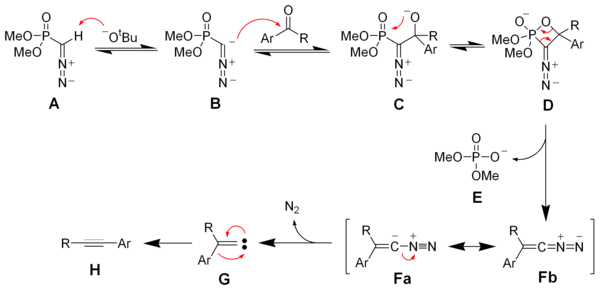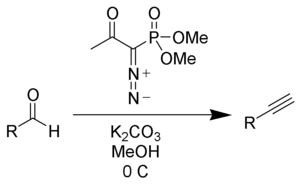- Seyferth–Gilbert homologation
-
The Seyferth–Gilbert homologation is a the chemical reaction of an aryl ketone 1 (or aldehyde) with dimethyl (diazomethyl)phosphonate 2 and potassium tert-butoxide to give substituted alkynes 3.[1][2] Dimethyl (diazomethyl)phosphonate 2 is often called the Seyferth–Gilbert reagent.[3]
This reaction is called a homologation because the product has exactly one additional carbon more than the starting material.
Contents
Reaction mechanism
Deprotonation of the Seyferth–Gilbert reagent A gives an anion B, which reacts with the ketone to form the oxaphosphatane D. Elimination of dimethylphosphate E gives the vinyl diazo-intermediate Fa and Fb. The generation of nitrogen gas gives a vinyl carbene G, which via a 1,2-migration forms the desired alkyne H.
Bestmann modification
Ohira-Bestmann Reagent  dimethyl (1-diazo-2-oxopropyl)phosphonate
dimethyl (1-diazo-2-oxopropyl)phosphonateIdentifiers CAS number 90965-06-3 Jmol-3D images Image 1 - O=P(OC)(OC)C(C(C)=O)=[N+]=[N-]
Properties Molecular formula C5H9N2O4P Molar mass 192.11 Except where noted otherwise, data are given for materials in their standard state (at 25 °C, 100 kPa) Infobox references Dimethyl (diazomethyl)phosphonate can be generated in situ from dimethyl-1-diazo-2-oxopropylphosphonate (also called Bestmann's reagent) by reaction with methanol and potassium carbonate. Reaction of Bestmann's reagent with aldehydes gives terminal alkynes often in very high yield.[4][5]
The use of the milder potassium carbonate makes this procedure much more compatible with a wide variety of functional groups.
Another modification for less reactive aldehydes is made by replacement of potassium carbonate with caesium carbonate in MeOH and results in a drastic yield increase.[6]
References
- ^ D. Seyferth, R. S. Marmor and P. Hilbert (1971). "Reactions of dimethylphosphono-substituted diazoalkanes. (MeO)2P(O)CR transfer to olefins and 1,3-dipolar additions of (MeO)2P(O)C(N2)R". J. Org. Chem. 36 (10): 1379–1386. doi:10.1021/jo00809a014.
- ^ J. C. Gilbert and U. Weerasooriya (1982). "Diazoethenes: their attempted synthesis from aldehydes and aromatic ketones by way of the Horner-Emmons modification of the Wittig reaction. A facile synthesis of alkynes". J. Org. Chem. 47 (10): 1837–1845. doi:10.1021/jo00349a007.
- ^ D. G. Brown, E. J. Velthuisen, J. R. Commerford, R. G. Brisbois and T. H. Hoye (1996). "A Convenient Synthesis of Dimethyl (Diazomethyl)phosphonate (Seyferth/Gilbert Reagent)". J. Org. Chem. 61 (7): 2540–2541. doi:10.1021/jo951944n.
- ^ S. Müller, B. Liepold, G. Roth and H. J. Bestmann* (1996). "An Improved One-pot Procedure for the Synthesis of Alkynes from Aldehydes". Synlett 1996 (06): 521–522. doi:10.1055/s-1996-5474.
- ^ G. Roth, B. Liepold, S. Müller and H. J. Bestmann (2004). "Further Improvements of the Synthesis of Alkynes from Aldehydes". Synthesis 2004 (1): 59–62. doi:10.1055/s-2003-44346.
- ^ Lidija Bondarenko, Ina Dix, Heino Hinrichs, Henning Hopf* (2004). "Cyclophanes. Part LII:1 Ethynyl[2.2]paracyclophanes – New Building Blocks for Molecular Scaffolding". Synthesis 2004 (16): 2751–2759. doi:10.1055/s-2004-834872.
See also
Categories:- Carbon-carbon bond forming reactions
- Rearrangement reactions
- Name reactions
Wikimedia Foundation. 2010.



